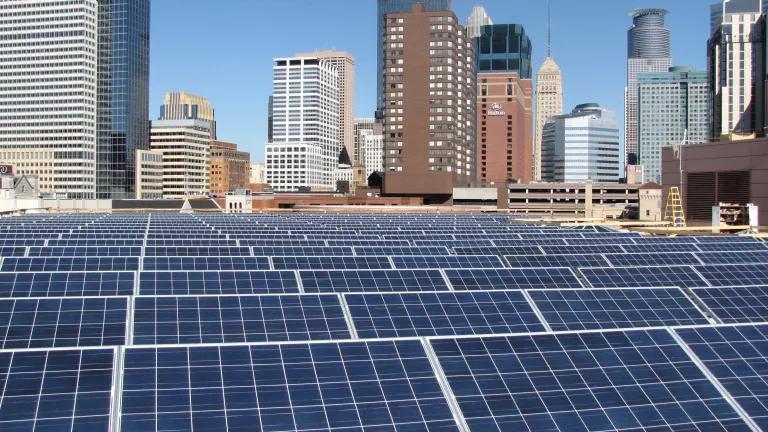Clean, Efficient, Equitable Buildings Infrastructure
The Build Back Better package is an important first step to meet the need for clean and efficient buildings, but it is only a first step in a marathon, and much more is going to be needed to decarbonize buildings affordably and equitably.

As part of its Build Back Better budget reconciliation proposal, the U.S. House of Representatives has included historic provisions to help clean up the homes and buildings in which we live, work, shop, and dine. Specifically, they have proposed approximately $50 billion in investments that will lower our energy bills, power our buildings with increasingly clean energy, improve indoor and outdoor air quality, and cut the greenhouse gas emissions that are driving the climate crisis. These investments are an important first step, but they are a small down payment for what is necessary to truly meet the need for averting the worst impacts of the climate crisis and advancing equity as laid out in President Biden’s Build Back Better agenda.
We spend up to 90 percent of our lives in buildings. Buildings are also where people experience major inequities, from housing insecurity, to rent and energy burden. Inefficient buildings and appliances lead to high energy bills that disproportionately burden low-income households and the combustion of methane gas and other fossil fuels in our buildings pose health and safety hazards, including poor indoor air quality.
In addition, buildings account for a significant share of our greenhouse gas (GHG) emissions. More than 76 percent of all U.S. electricity and more than 40 percent of all U.S. energy and associated GHG emissions are used to heat, cool, light, and otherwise power U.S. residential and commercial buildings. Buildings also use 25 percent of all methane gas in the United States. Transitioning to fossil-fuel-free, efficient, and healthy buildings is not only an essential component of any economy-wide decarbonization strategy, but also an opportunity to improve people’s everyday lives, create family-sustaining jobs, and improve indoor and outdoor environmental quality for all.
Electrification and Energy Efficiency
For the first time, the House Energy and Commerce committee proposed provisions to help home and building owners transition from inefficient and polluting fossil-fuel appliances for heating, hot water, drying, and cooking to super-efficient electric alternatives such as heat pumps that will make the air cleaner in our homes and communities, and reduce energy bills. Electrification is a critical pillar for decarbonizing buildings, together with energy efficiency and clean energy. Energy efficiency and cleaning up the electric grid are key but insufficient to achieve the decarbonization targets necessary to avert the worst impacts of the climate crisis, since continued burning of fossil fuels in furnaces and water heaters would remain a major source of climate and air pollution.
Energy efficiency remains an essential pillar of affordable decarbonization: it is needed to save people money on their utility bills and minimize the incremental demand on the electric grid as buildings and vehicles switch from polluting fossil fuels to increasingly clean electricity. Efficiency includes improved building envelopes through weatherization, as well as more efficient appliances for heat, hot water, clothes drying, and cooking. Heat pumps are inherently much more efficient than conventional gas and electric technologies, but heat pump efficiencies vary wildly, and incentivizing better products is key for affordable decarbonization.
Key Build Back Better Measures for Buildings
The main elements of the Build Back Better bill that support building decarbonization include:
- $18B for appliance and building efficiency and electrification rebates, including home energy efficiency retrofits, and conversion from inefficient fossil-fuel-burning furnaces, water heaters, dryers, and cooktops to efficient electric alternatives such as heat pumps and induction cooktops. Low-to-moderate income (LMI) households are eligible for higher rebates and more than 60 percent—$5.5B out of $9B electrification funds—are reserved for LMI and tribal households. This program also includes $500M to train workers on home energy efficiency retrofits through the State Energy Program.
- $17.5B for the Federal Energy Efficiency Fund, which provides grants to federal agencies to implement projects that conserve energy, save money through renewable energy, energy retrofits and electrification, energy storage, and equipment efficiency.
- $7B for building efficiency and resilience, including expansion of the under-resourced Weatherization Assistance Program, which provides comprehensive energy assessments to identify and implement the most cost-effective measures to reduce energy bills and address health and safety concerns in low-income households. This also provides funding to states for critical facility modernization to help vital government and non-profit services remain operational when significant weather events disrupt people’s lives.
- $5B for energy efficiency and conservation block grant, delivering funding to states and local governments for the deployment of energy distribution technologies that significantly increase energy efficiency, and programs for financing energy efficiency.
- $5B for environmental and climate justice block grants to community-led projects that address environmental and public health harms related to pollution and climate crisis. This grant program provides direct funding to the communities most impacted by climate change and environmental injustice, funding local projects and solutions to decrease pollution and increase climate readiness.
Seizing the Moment
The Build Back Better package is an important first step to meet the need for clean and efficient buildings, but it is only a first step in a marathon, and much more is going to be needed to decarbonize buildings affordably and equitably. Still, it is vital to get started on this journey and start with our best foot forward, so we have a strong foundation to build upon it in the coming years.
Congress must preserve and enhance the provisions and funding amounts of the Build Back Better Act that will kickstart the transition to clean, efficient, and healthy buildings.


